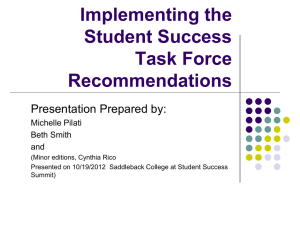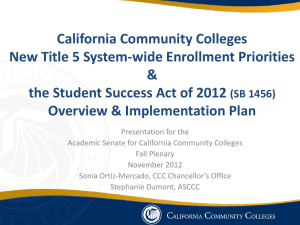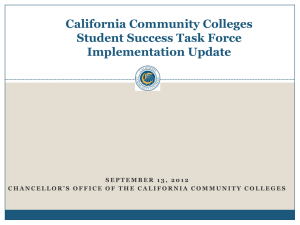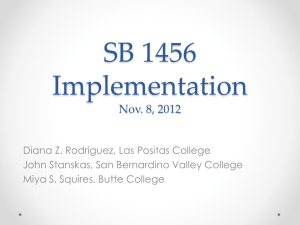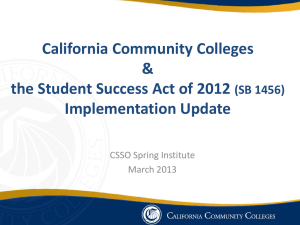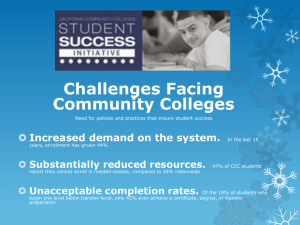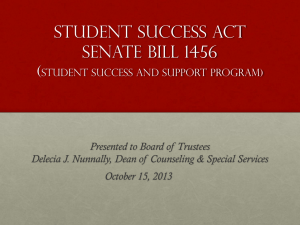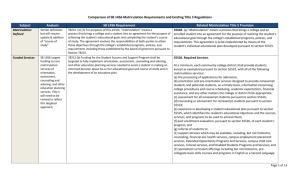Implementating the Student Success Task Force Recommendations
advertisement
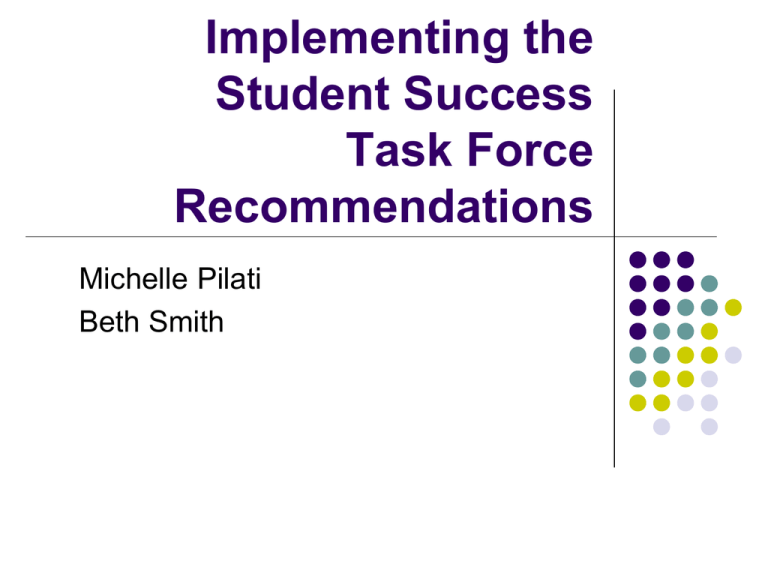
Implementing the Student Success Task Force Recommendations Michelle Pilati Beth Smith Orienting Your Presenters Who are you? What are you hoping to get from this presentation? Overview General Themes Current status Implementation of SB 1456 Summits/Workgroups Legislation/Title 5 Guidance for local responses Questions and discussion General Themes ① ② ③ ④ ⑤ ⑥ Changing student behavior & streamlining college practices. Greater use of technology to serve more students. Greater degree of centralization for system—more control for Chancellor’s Office. More impact on students on the front end. Strategically ”rationing education”. Get students through more quickly and get out those who are not making progress toward a specific goal. General Themes in Context ① Changing student behavior & streamlining college practices. Recent changes? Student behavior: Withdrawal policies >> changes in drop dates Limits on W and repetition for a substandard grade >> each take is high stakes College behavior/practices: Repeatability General Themes in Context Federal financial aid: Federal financial aid will cover no more than two “takes” Note: federal financial aid will cover additional “takes” if a substandard grade is earned, but only if the grade is an F (state and federal definitions differ) CRITICAL that colleges be alerting students to all of these changes – as well as those that have not yet been implemented. College culture needs to change in advance of full implementation of the SSTF recommendations. General Themes in Context ② ③ Greater use of technology to serve more students. Some college exploration, nothing happening centrally – yet What technological “solutions” could best support our students today? Greater degree of centralization for system—more control for Chancellor’s Office. Legislation that would have decreased the role of DOF did not move forward No changes - yet General Themes in Context ④ ⑤ ⑥ More impact on students on the front end. Strategically ”rationing education”. Enrollment priorities? Get students through more quickly and get out those who are not making progress toward a specific goal. Enrollment priorities? BOG waiver changes? Transfer degrees? Current Status SB 1456 signed September 27 Implementation to follow Task groups to be formed Summits held Basic Skills Professional Development Future summit Enrollment management Implementation of SB 1456 … Governor Brown signed Senate Bill 1456, the Student Success Act of 2012. This bill establishes the framework to implement several Student Success Task Force recommendations, specifically the Student Success Initiative (re-purposing of Matriculation) and Board of Governors Fee Waiver academic conditions. Lowenthal – SB 1456 Substantial modifications to existing Ed Code language pertaining to matriculation. BOGFW – (B) meet academic and progress standards (including unit cap). Lowenthal – SB 1456 “student’s responsibilities” Identify educational goal upon enrollment Declare specific course of study within a reasonable time Attend class and complete assignments Maintain progress “institution’s responsibility” Provide student services – orientation, assessment, counseling and ed planning, referral to needed and available support services.. Lowenthal – SB 1456 “institution’s responsibility” (continued) (E) Evaluation of each student’s progress and referral to appropriate interventions.. 78213. (d) When the board of governors adopts a system of common assessment, community colleges may use supplemental measures for placement.. 78214. Accountability Lowenthal – SB 1456 78215 – Requires all nonexempt students to complete orientation and assessment and to develop education plans. (b) these policies shall be phased in over a reasonable time as determined by the BoG…. 78216. BoG shall develop a formula for allocating funding.. Requires use of common assessment and scorecard. Implementation of SB 1456 Webinars, website, and E-Mail dedicated to providing information and answering questions Groups to be convened: Matriculation regulation revision Matriculation MIS and Allocation Formula Student Equity Program Reporting Matriculation Issues to be Addressed Reporting requirements were waived due to “flexing” of funds Presently unclear how many students receive a full array of matriculation services Accurate and consistent reporting is needed How do we increase capacity absent funding to do so? Definitions Initial education plan Vs comprehensive (for example) Basic Skills Summit Developed vision for “Poppy Copy II” Focus on lessons learned/institutional and cultural change Guiding Principles and Values Student-focused Integrated Reality check Professional Development (PD) Summit VISION STATEMENT: To support the mission of the California Community Colleges and to promote an inclusive statewide and local learning culture, all personnel will have ongoing opportunities to develop and expand the skills and practices that influence students’ ability to complete their educational goals. PD Workgroups Workgroup #1 – .. will work on Changes to the Flex Calendar Program Workgroup #2 – .. will work on what the Chancellor’s Office can do to help move professional development forward in the System Workgroup #3 – .. will work on the website to house various professional development resources Workgroup Status Score Card, recommendation 7.3 Work generally done Details with respect to counselor:student ratio TBD Student Success Initiative, recommendation 8.2 – SB 1456 Matriculation Advisory Committee CO Advisory Group on Counseling (COAGC) Workgroup Status BOG Fee Waiver Requirements, recommendation 3.2 – SB 1456 Financial Aid Technical Advisory Committee Enrollment Priorities, recommendation 3.1 done Active Workgroups? Common Assessment, recommendation 2.1 CCCAssess One meeting Determining focus given limited funding Common Core Standards, recommendation 1.1?? Basic Skills (5.1, 5.2, 6.2, 8.3) Basic Skills Advisory Committee? Implementation Details Score Card, recommendation 7.3 ARCCC >> Scorecard Cohort comparison >> Self comparison Challenge – Context for data Enrollment Priorities, recommendation 3.1 Title 5 language was adopted by the BoG Date certain for implementation Enrollment Priorities Overview Level I – Groups mandated in Ed Code Level II – Groups mentioned in Title 5 foster youth veterans DSPS students who need accommodations EOPS students Level III – New students who have been through matric, continuing students in good standing, and less than 100 units Some Details Only Level I must be implemented during summer and intersession. All degree-applicable units count towards the 100 unit limit. Loss of priority may be imposed after the student is back in good standing. Time certain for implementation – registration for Fall 2014. Next Steps: State New regulations and legislation ASCCC is monitoring & participating Normal governance procedures at state level: Consultation Council Or for strictly academic matters, the ASCCC has recommending authority for 10 + 1 areas Next Steps: Local Prerequisites: consider opportunities to implement appropriate pre reqs. (Course sequencing). Three “takes” of a course What messages do you have for students? What messages do you have for full-time AND parttime faculty? What interventions do you have in place? Prepare locally for regulation changes: Look at policies & practices for assessment, placement, registration priorities. Consider forming committee. ASCCC and BOG of Exemplary Award to honor outstanding assessment practices Continuous Improvement of Instruction Explore new delivery methods Investigate scheduling options (also helps with three “takes”) Examine curricular processes for obstacles that prevent or slow faculty responses to local needs Basic Skills Instruction Rewrite curriculum – contextualization, better distinction of levels from CB21 coding, compressed courses Participate in training and professional development when possible Innovation at one college is not equal to innovation at another college Be true to your faculty and students Examine noncredit as a possibility Questions?
